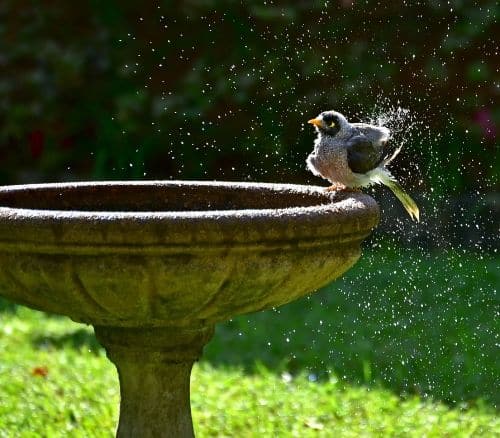Imagine being outside in a thriving wildlife garden. The sound of birds chirping and bees buzzing from one flower to another. Butterflies flutter around before your eyes. The garden hums with activity. You don’t need acres of land or a countryside garden to watch nature thrive – you can turn even the smallest garden in a nature haven. Here are four easy ways to create a wildlife haven in your garden.

Bird table
Many of us feed the birds, but did you know they also struggle to find clean water to drink? They will really appreciate a small bird table to drink and bathe.
Put it somewhere you can see it from the house and keep it topped up with clean, fresh water. Empty and clean it with a mild detergent if it develops algae.
Bird boxes
Give birds a place to sleep and nest with a wooden bird box. They are inexpensive and so easy to use – here’s an explanation of the different types:
There is a huge range of bird boxes, but the main difference is the entrance. A small 25mm or 28mm hole is best for small varieties like blue tits and 32mm is ideal for great tits, flycatchers and house sparrows. And an open front is best for robins and wrens.
Bird boxes should be hung off the ground in a sheltered spot. Make sure the front isn’t exposed to wind and driving rain. Open-fronted bird boxes should be lower and nestled in amongst vegetation for cover. Put nest boxes up in autumn or spring, and be patient – it may take a while before you get residents.
Insect hotels
Many garden plants need pollinating insects to produce fruit and flowers. But their numbers are in decline, partly due to a loss of habitat. Make your garden a safe haven for essential solitary bees, ladybirds and lacewings.
Solitary bees do not live in colonies like honeybees, and they hardly ever sting. They lay their eggs in holes bored into trees by other insects, and you can mimic that environment in the garden. Drill small holes of various sizes into logs and leave them in the garden.
Or why not make a whole insect hotel from recycled household objects like the one above? Check out my step-by-step guide here.
Butterfly feeders

Butterflies are a common sight in the garden, and love nectar-rich plants. You can attract them with species like lavender and buddleja. In fact, there is a huge number of beautiful plants that pollinators love.
But if you don’t have space in your small garden, create a butterfly feeder instead. They love things rich in sugar like slices of over-ripe orange or soft fruits. Place them on a dish near some colourful flowers.
Or make a sugar syrup mix with sugar and water and pour into a shallow Tupperware box. Pop in a couple of brightly coloured scouring pads to attract the butterflies and give them somewhere dry to land.
Want more small garden inspiration? Check out the designs for the Young Gardeners of the Year competition!
With these tips you can have a garden that’s thriving with biodiversity, making a fascinating wildlife haven.

Oh, yes! If the vegetables, herbs & flowers feed the joy of the gardener’s soul, the birds and insects are the crowning music! I’ll be inviting more to my garden this year with your tips. Thanks for sharing.
Great tips. Had no idea about the bugs. I’m definitely going to try to make a bug haven.
Keep up the great work, we all must help God’s little creatures!!